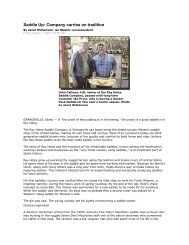The Elements of the Saddle: The Tree - sbbchidaho.org
The Elements of the Saddle: The Tree - sbbchidaho.org
The Elements of the Saddle: The Tree - sbbchidaho.org
You also want an ePaper? Increase the reach of your titles
YUMPU automatically turns print PDFs into web optimized ePapers that Google loves.
<strong>The</strong> No. 209 - Our version <strong>of</strong> <strong>the</strong> old “3B†tree is considered by many as <strong>the</strong> most useful and<br />
commonsense roper made today. <strong>The</strong> fork on this tree sits about 1 1/2 inches higher than <strong>the</strong> Homestead, which<br />
gives a little more security. In addition to this, it comes in any width, from 9 to 12 inches. <strong>The</strong> cantel can be had in<br />
heights from 1 1/2 to 4 inches. with a horn <strong>of</strong> your own specifications. This tree can be made to fit <strong>the</strong><br />
requirements <strong>of</strong> most riders.—From a page <strong>of</strong> <strong>the</strong> Ray Holes <strong>Saddle</strong> Co. catalog.<br />
<strong>The</strong> goal is even, equal contact between rider and saddle from <strong>the</strong> crotch to <strong>the</strong> calf, where <strong>the</strong><br />
horse’s rib cage falls away from <strong>the</strong> rider’s leg, with no lumps, bumps or hollows to cause ei<strong>the</strong>r<br />
an excess or absence <strong>of</strong> contact. While this sounds like a simple objective, it requires an<br />
experienced saddlemaker to achieve it while shaping <strong>the</strong> seat to allow <strong>the</strong> right combination <strong>of</strong><br />
freedom versus security and maintaining <strong>the</strong> proper position <strong>of</strong> balance in relation to <strong>the</strong> stirrup<br />
lea<strong>the</strong>rs. I encourage serious students <strong>of</strong> horsemanship to be observant and develop an “eye”<br />
for <strong>the</strong> shape that constitutes a useful, balanced and comfortable seat. Variations <strong>of</strong> <strong>the</strong> basic<br />
seat shape can be made to accommodate physical deformity or injury or specialized horse<br />
sports, such as cutting or calf roping or to adjust <strong>the</strong> width for a woman’s saddle. <strong>The</strong> inside <strong>of</strong><br />
<strong>the</strong> thigh is usually fuller and rounder than a man’s, requiring a seat that is narrower in <strong>the</strong><br />
waist to maintain that even contact, beginning with <strong>the</strong> tree being made slightly narrower in<br />
that area. In <strong>the</strong> post-war years, saddleries employing a crew <strong>of</strong> journeymen began to be<br />
replaced by production-line factories.<br />
Through erosion <strong>of</strong> saddlemaking skills and hiring cheaper, less skilled labor, <strong>the</strong> techniques<br />
required to produce correctly shaped seats were <strong>of</strong>ten lost, ignored or camouflaged with thick<br />
foam padding.



